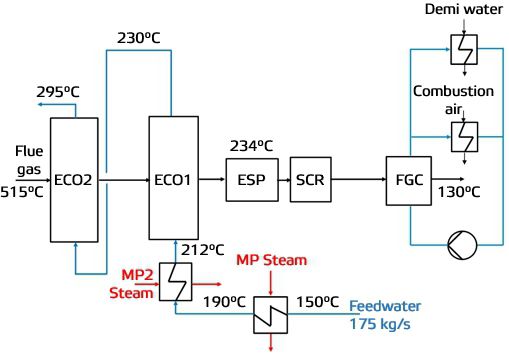Recovery boiler selective catalytic reduction - a retrofit case
Mar 13, 2018
SCR – Selective Catalytic Reduction is a well-established and widely used technology for NOx removal from power boiler flue gases. Until now there has not been any need to utilize SCR in recovery boilers. Sufficient 200 mg/m3 (6% O2, dry gas) is an achievable NOx emission level with primary means only. There indications from China and some European countries that the target emission level will be 100 mg/m3 (6% O2, dry gas) in the near future. This is not achievable by air staging or even by SNCR in recovery boilers with normal kraft black liquors having N2 content of 0.1 % or higher in dry solids.
In recovery boiler retrofit cases there are three challenges for SCR: SCR reactor inlet flue gas temperature, probable SO2 in the flue gas and excess particulate concentration after the electrostatic precipitator. Flue gas temperature should be ~250 °C and SO2 preferably below 5 mg/m3 to avoid formation of harmful ammonium bisulfate. Dust concentration should stay below 30 mg/m3n after ESP to avoid catalyst blockages. New recovery boilers run with very low SO2 emissions but some variation and peaks may occur. The desired temperature is achievable with certain high power features. Additional electricity production creates good payback for the high power investments.
In the white paper found HERE a theoretical study is presented for a retrofit case of a recovery boiler where an SCR is utilized to lower NOx from 200 to 100 mg/m3 (6% O2, dry gas). Necessary high power features are implemented to raise the flue gas temperature high enough for the SCR.
A high power concept with two feedwater preheaters, a flue gas cooler, added stages of air preheaters, and a demi water heater was developed to increase power production and to achieve the target flue gas inlet temperature for the SCR, as seen in this graphic.

High power features used in recovery boiler SCR
With two feed water preheaters, the flue gas temperature can be controlled to the acceptable level even on partial loads of the boiler. An additional superheater was needed to maintain attemperation and the steam temperature.
A fourth ESP with flue gas ducting was added to the boiler because of the higher flue gas temperature. Each flue gas line was furnished with an SCR reactor. Under situations of too low temperature or too high dust or SO2 concentration of the flue gas, the reactor can be isolated from the flue gas duct by a bypass duct. The first reaction of controls to these situations would be shutting down the ammonia injection. Rapid information about temperature, particulates and SO2 are needed for controls.
A 14 % increase in electricity production, being 13 MW, was achieved with the used high power concept. With this extra electricity, the investment in high power was estimated to be paid back in 1.7 years. The total investment was paid back in 4.7 years by additional revenue from the extra electricity.
For more information on reducing NOx emissions in your recovery boiler, contact your Valmet representative.